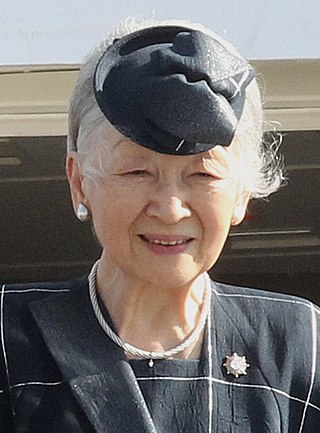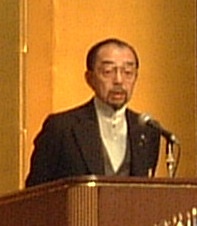Related Research Articles

The Imperial Palace is the main residence of the Emperor of Japan. It is a large park-like area located in the Chiyoda district of the Chiyoda ward of Tokyo and contains several buildings including the Fukiage Palace where the Emperor has his living quarters, the main palace where various ceremonies and receptions take place, some residences of the Imperial Family, an archive, museums and administrative offices.

Michiko is a member of the Imperial House of Japan. She was Empress of Japan as the wife of Akihito, the 125th Emperor of Japan reigning from 7 January 1989 to 30 April 2019.

The Imperial Household Agency (IHA) is an agency of the government of Japan in charge of state matters concerning the Imperial Family, and the keeping of the Privy Seal and State Seal of Japan. From around the 8th century AD until the Second World War, it was known as the Imperial Household Ministry.

Aiko, Princess Toshi is a member of the Imperial House of Japan. She is the only child of Emperor Naruhito and Empress Masako of Japan.

A National Treasure is the most precious of Japan's Tangible Cultural Properties, as determined and designated by the Agency for Cultural Affairs. A Tangible Cultural Property is considered to be of historic or artistic value, classified either as "buildings and structures" or as "fine arts and crafts". Each National Treasure must show outstanding workmanship, a high value for world cultural history, or exceptional value for scholarship.

Akasaka Palace is a state guest house of the government of Japan. Other state guesthouses include the Kyoto State Guest House and the Osaka State Guest House.

Kiko, Crown Princess Akishino, is the wife of Fumihito, Crown Prince of Japan. Her husband is the younger brother and heir presumptive of Emperor Naruhito and the second son of Emperor Emeritus Akihito and Empress Emerita Michiko.

Prince Tomohito of Mikasa was a member of the Imperial House of Japan and the eldest son of Takahito, Prince Mikasa and Yuriko, Princess Mikasa. He was a first cousin of Emperor Akihito, and was formerly sixth in the line of succession to the Japanese throne and the heir apparent to the princely house of Mikasa-no-miya and the title "Prince Mikasa". Prince Tomohito was the first member of the Imperial House of Japan with a full beard since Emperor Meiji, thus earning him the popular nickname of the "Bearded Prince". He died of cancer on 6 June 2012, aged 66.

Princess Tomohito of Mikasa is a member of the Japanese Imperial Family as the widow of Prince Tomohito of Mikasa.

The Imperial House is the reigning dynasty of Japan, consisting of those members of the extended family of the reigning emperor of Japan who undertake official and public duties. Under the present constitution of Japan, the emperor is "the symbol of the State and of the unity of the people". Other members of the imperial family perform ceremonial and social duties, but have no role in the affairs of government. The duties as an emperor are passed down the line to their male children. The Japanese monarchy is the oldest continuous hereditary monarchy in the world. The imperial dynasty does not have a name, therefore its direct members do not have a family name.

Aoyama-itchōme Station is a subway station in Minato, Tokyo, Japan operated by Tokyo Metro and Tokyo Metropolitan Bureau of Transportation (Toei).

The Museum of the Imperial Palace of Manchukuo is a museum in the northeastern corner of Changchun, Jilin province, northeast China. The palace was the official residence created by the Imperial Japanese Army for China's last emperor Puyi to live in as part of his role as Emperor of the Japanese puppet state of Manchukuo. In the People's Republic of China the structures are generally referred to as the Puppet Emperor's Palace & Exhibition Hall. It is classified as a AAAAA scenic area by the China National Tourism Administration.
Ōmiya Palace refers to a residence of the Empress Dowager of Japan. Literally, Ōmiya means Large Palace, but it is also a courtesy title of the Empress Dowager. Thus, the name Ōmiya Palace does not refer to any specific place, such as Ōmiya-ku, Saitama. In the modern history, there are three palaces called Ōmiya Palace:

Chihaya Castle is a late Kamakura period Japanese castle located in the village of Chihayaakasaka, Osaka Prefecture, Japan. Its ruins have been protected as a National Historic Site since 1934.
In Japan, the Sentō Imperial Palace traditionally does not refer to a single location, but to any residence of retired emperors. Before Akihito abdicated in 2019, the last Emperor to retire did so in 1817, so the designation commonly refers to the historical Kyoto Sento Imperial Palace (京都仙洞御所).
In Japan, the Tōgū Palace traditionally does not refer to a single location, but to any residence of the imperial crown prince. As Prince Akishino, the current heir presumptive, is not a direct male descendant to the Emperor and not an imperial crown prince himself, there is currently no Tōgū Palace in Japan and there will not be one until there is another imperial crown prince.
The biota of Tokyo Imperial Palace grounds, especially of the Fukiage Garden, consists of enriched and distinct flora and fauna found in Tokyo, Japan. An untouched, vast open space in the middle of Tokyo hosts diverse species of wildlife which have been catalogued in field research. For comparison, this article also covers biodiversity in other open spaces in the central districts of Tokyo.

The Takanawa Imperial Residence is an Imperial residence in Tokyo.

The Akasaka Estate is a park-like Japanese Imperial Estate, site of several major existing and former Imperial residences in the district of Moto-Akasaka, Minato Special Ward, Tokyo. Besides Prince Hitachi, who lives in Higashi, Shibuya, many members of the Imperial Family have their official residence on this estate, including the Emperor Emeritus. The estate is not accessible to the general public.

The Rikyū-in (離宮院跡) is the ruins of a detached palace located in the Obata neighborhood of the city of Ise, Mie Prefecture, Japan. It was designated a National Historic Site in 1924.
